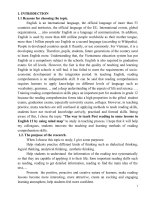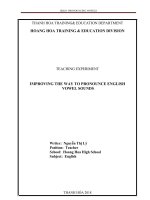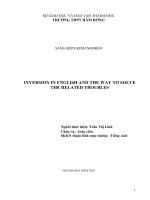Improving the way to pronounce english vowel sounds
Bạn đang xem bản rút gọn của tài liệu. Xem và tải ngay bản đầy đủ của tài liệu tại đây (148.36 KB, 11 trang )
SKKN- PRONOUNCING VOWELS
THANH HOA TRAINING& EDUCATION DEPARTMENT
HOANG HOA TRAINING & EDUCATION DIVISION
TEACHING EXPERIMENT
IMPROVING THE WAY TO PRONOUNCE ENGLISH
VOWEL SOUNDS
Writer: Nguyễn Thị Lý
Position: Teacher
School: Hoang Hoa High School
Subject: English
1
THANH HÓA 2018
SKKN- PRONOUNCING VOWELS
TABLE OF CONTENTS
Number
1
Content
INTRODUCTION
1- Justification of the research
2- Aim and objectives of the research
3- Scope of the research
4- Method of the research
4.1. Subject of the research
4.2. Data collection instrument of the research
4.3. Data analysis procedure of the research
Page
2
2
3
3
4
DEVELOPMENT
2
Part 1: Theoretical background
English pronunciation
1- Standard English pronunciation
2- English sounds
Part 2: Practical background
Errors concerned with vowel sounds
1. Description of vowel sounds errors
2. Error analysis
3.Typical vowel sounds error collected from the survey
Part 3: Possible causes and suggested solutions
1. Possible causes
1.1. Lack of awareness of the importance of
pronunciation
1.2. Teachers’ neglect of pronunciation.
1.3. Mother tongue interference.
2. Suggested solutions
Doing pronunciation exercises
a. Distinguishing sound exercises
b. Find the odd sounds
c. Matching exercises
4
4
7
7
8
9
9
10
2
SKKN- PRONOUNCING VOWELS
INTRODUCTION
1-Justification of the research
We all know that during the time of studyingEnglish, there are many
pronunciation errors that High school students of English tend to make such as
word and sentence stress, intonation, length of vowel sounds, ending sounds and
linking sounds, etc. To help better English pronunciation for students of English at
High school, it's is essential to do a search on most typical pronunciation problems
of Vietnamese students, which is, in this research, errors with vowel sounds.
Secondly, for High students, who have to learn English as their main subject,
and then take exams in which English is one of the compulsory subjects. It's
extremely significant to realize their pronunciation errors. They cannot self-correct
their English pronunciation so they are not confident enough to communicate in
English. It’s obvious that there are some students noticing their pronunciation
errors when their pronunciation erroneously, others, on the other hand, don't
recognize their problem with pronunciation English words.
Last but not least, although there are common errors made by learners, not at
all teachers pay attention to them. The above conclusion partly from personal
observation supports this research. It is possibly becausesome sounds are not
pronounced so clearly as other sounds in an utterance so they are less noticed by
both learners and teachers. Added to this, there have not been many studies on
these particular pronunciation errors so far at high level. Only studies about general
speaking and pronunciation errors were carried out, which appears to have failed to
emphasize the main pronunciation problem of Vietnamese students of English.
I believe that a study on English pronunciation errors will help students
become well aware of their pronunciation problems to which they might not have
paid any attention before. It’s also the help for some teachers in teaching
pronunciation at schools if the study can suggest some solutions to help students
practice pronunciation individually and in group. From the reasons mentioned
above, I have decided to carry out this study entitled "Improving the way to
pronounce English vowel sounds ”.
2. Aim and objectives of the research
English phonetics is important as it lays basis for effective oral
communication. As far as I know, students of English at primary schools are not
taught phonetics(and students at secondary schools who learn new curriculum are
taught some sounds) and mostly taught by nonnative- English teachers.
Classes in Viet Nam are big so it is not suitable for teachers and students to
practice pronunciation.
For those reasons, I decided to do a study on pronunciation errors made by
students in High schools to analyze the errors, their causes and the suggest some
3
SKKN- PRONOUNCING VOWELS
solutions based on my own experiences in teaching English to help students
improve their pronunciation as well as to present to teachers of English a realistic
picture of pronunciation errors made by their students so that they can find the
suitable and effective methods to teach this subject with their students.
3. Scope of the research
The study focuses on English errors made by students in Grade 10, I do not
have an ambition to cover all the students' problems with English pronunciation.
Only the pronunciation errors with some typical vowels made by the students in
high school are investigated.
4. Method of the research
4.1 Subjects of the research
This school year, there are about 100 students from three classes- 10 A1,
10B2 and 10A4 at Hoang Hoa High school but I choose 50 students participating in
this study. They are about the same age; both genders and they come from many
villages in Hoang hoa district.
4.2 Data collection instruments of the research
Information in the study is collected in a natural way. In order to analyze the
pronunciation errors that students in grade 10 make in their utterances, I have been
observing in their lessons in class for many years and write down students' errors.
Then I analyze at home with the help of the attached CD and typescripts in the
course book " Pronunciation Made Simple" provided by an American teacher Ms.
Mindy and many video clips about pronunciation on YouTube.
4.3. Data analysis procedure of the research
Firstly, I took students' errors, checked whether they knew how to pronounce
the words or not, I also counted how many students selected each pronunciation.
Secondly, I compared students' errors with the guide books, sample videos.
Thirdly, I asked my colleagues about how to pronounce the words in the survey and
the errors that students made
DEVELOPMENT
PART 1: THEORETICAL BACKGROUND
This first partwill provide readers with the related theoretical background of
the study by introducing some key concepts necessary for the best perception of
this research as well as the review of previous studies related to the topic. Central
concepts chosen to be clarified in this part are English pronunciation, Standard
pronunciation, English pronunciation Errors Aspects of pronunciation such as the
articulator and English sounds.
English pronunciation
Since the research have a strong desire to investigate the pronunciation errors
in English, the definition of English pronunciation is especially important.
4
SKKN- PRONOUNCING VOWELS
Commonly speaking, pronunciation is simply put as "the way in which a language
is spoken"(1)
1- Standard English Pronunciation
Standard Englishis the most preferable accent in any setting and to teach
students.It is considered to be neutral, easier to remember and imitate as compared
to regional accents and it is heard on radio and TV (2). Nowadays English has
become the common mean of communication, it is no longer the own property of
British people, a standard pronunciation in one place may not be as much standard
in others.
2- English sounds
There are 44 sounds in English. They are divided into two groups: 20 vowel
sounds including 12 pure vowels, 8 diphthongs and 24 consonants sounds. It is too
large for me to study all the sounds so in this study, I just focuses on pure vowels.
Pure vowel sounds
Vowels are “sounds in the production of which there is no obstruction to the
flow of air as it passed the larynx to the lips" (3). Vowels are divided into two groups:
pure vowels(monothongs) and dipthongs.
In the study, only the pure vowel sounds focused on. Monothongs are pure vowel
sounds and when we pronounce them, the organs of speech remain during the
process of pronunciation.
According to Kelly (2000:29), monothongs are classified based on four criteria:
* Shape of lips(mouth)
+ Spread: The shape of lips is spread: /i:/, /i/, /e/,/æ /
+ Unrounded: The shape of lips is unrounded: /з:/, /∂/, /ʌ/
+ Rounded: The shape of lips is rounded: /u:/,/ɔː/, /ɑː/, /ʊ/, /ɒ/
* Position of tongue in the mouth:
The position of tongue has a close relation to:
+High: Mouth is closed: /i/,/i:/, /uː/, /ʊ/
+ Middle: Mouth is half-way open: /e/,/з:/, /ɔː/
+ Low: Mouth is open and wide: /æ /,/ɑː/, /ɒ/, /ʌ/
*The highest part of the tongue( the part of the tongue which is raised)
+ Front vowels: /I/, / i:/, /e/, /æ/
+ Central:/з:/,/ʌ/, /ə/
+ Back: /ʊ/, /ɑː/, /ɒ/, /ɔː/, /uː/
* The length of sounds:
+Short vowels: /I/, /e/, /æ/, /ɒ/,/ʊ/, /ə/, /ʌ/
+ Long vowels:/i:/, /ɜː/, /ɔː/, /ɑː/, /ɔː/(4)
Pure vowel sounds in words:
- /i:/ as in these words: bead, key, people, meat………
-/ i/as in these words: hit, rhythm, women…………..
5
SKKN- PRONOUNCING VOWELS
- /ʊ/as in these words: push, pull, good, book, ………….
- /uː/as in these words: food, soup, true, who, fruit………
-/e/ as in these words: instead, any, said, head, left, egg……….
- /ə/ as in these words: machine, Japan, about, avoid, banana, paper……..
- /ɜː/ as in these words: nurse, birth, surf, her, word, serve……..
- /ɔː/ as in these words: call, daughter, taught, wall, board, saw……..
- /æ / as in these words: hat, black, bank, plastic, plan………..
- /ʌ/ as in these words: but, come, mother, uncle, front, flood……..
- /ɑː/ as in these words: car, clerk, far, part, half………..
- /ɒ/as in these words: dog, cough, because, knowledge……….
Illustration of how to pronounce pure sounds by pictures
6
SKKN- PRONOUNCING VOWELS
(5)
PART 2: PRACTICAL BACKGROUND
Errors concerned with vowel sounds
1. Description of vowel sounds errors
Number
Target sounds
Mispronounced sounds Number of errors
1
/ɪ/
/i:/
17
2
/æ /
/e/
16
/ɑː/
15
3
/ʊ/
/uː/
12
2. Error analysis
a- /ɪ/ sounds error analysis
The checking of the pronunciation errors reveals that many words containing
the /ɪ/ sounds are mispronounced into /i:/ sound and many students regarded /ɪ/
sounds as one of the most difficult to them./ɪ/ is a short vowel sound but /i:/ is a
long one. However, when students pronounced/ɪ/, it sounds like /i:/. The error is
made from the wrong way or the wrong manner they pronounce this sound and the
shape of lips also has influence on creating the error because we all can produce
/i:/sounds with the spread and loose lips so it is very easy for students to produce
sound /i:/ with the same shape of lips as in sound /ɪ/. Besides, I notice that there is
one more reason to interpret why Vietnamese students often mistake/ɪ/ and /i:/
sound. That is because of Vietnamese alphabet interference. The students must have
taught how to read and write letters in alphabet when they were children and they
7
SKKN- PRONOUNCING VOWELS
keep the way of reading Vietnamese letters in their mind in every time and
everywhere.
b- /æ / sound error analysis
When pronouncing, /æ / sound is often mispronounced into monothong /ɑː/
or /e/. Students do not open their lips neutrally, they keep their lips loosely spread
that may become the first condition for them to pronounce /e/ not /æ / sound. In
addition, the different positions of their tongue also make them produce different
sounds. The students when pronouncing /æ / sounddo not raise the front of their
tongue to just below the half-open position, they put either the front of their tongue
between the half-open and half- close position or the tongue between the center and
the back in the fully open position. Therefore, they produce either /ɑː/ or /e/
sounds.
c- /ʊ/sound error analysis
/ʊ/ is short vowel sound but /u:/ is a long one. From the survey, 12 students agree
that /ʊ/ is the most difficult sound and 12 students choosing the pair of sound /ʊ/
and /u:/ to be one of the most difficult pair sound to pronounce. The confusion of
the two sounds is simply understood. When pronouncing /ʊ/ sound, the students
often keep their lips rounded as in /u:/ sound meanwhile /ʊ/ sound needs the loose
rounded lips. The other reason is that students do not know to follow the rule to
pronounce /ʊ/.( to pronounce /ʊ/ sound, learners should raise the part of their
tongue just behind the center and above the half - close position, not the back of
their tongue just below the close position)
3. Typical vowel sounds error collected from the survey(8)
Target
Target
Pronunciation Mispronunciation Frequency of
sounds
words
errors(times)
/ɪ/
Delay
/dɪˈleɪ/
/di-lei/
7
In
/ɪn/
/i:n/
8
Delete
/dɪˈliːt/
di-lit
6
Sit
/sɪt/
/s i:t/
7
/æ /
Bad
/bæd/
/bed/
8
Grand
/grænd/
/grend/
9
Land
/lænd/
/lend/
6
Bank
/bænk/
/benk/
6
Snack
/snæck/
/sneck/
7
/ʊ/
Put
/pʊt/
/pu:t/
8
Pull
/fʊl/
/fu:l/
8
Look
/lʊk/
/lu:k/
6
Wood
/wud/
/wu:d/
7
8
SKKN- PRONOUNCING VOWELS
PART 3: POSSIBLE CAUSES AND SUGGESTED SOLUTION
1- Possible causes
Too much of the concern about teaching pronunciation has centered on the
exact pronunciation of vowel and consonant sounds. However, if the ambition of
English teaching is to enable learners to communicate in English, we can see that
communicative effectiveness depends on not only correct pronunciation of these
vowel and consonant sounds but also speakers themselves. Being able to use the
rhythm and intonation of English will enable speakers to be much more intelligible
than being able to pronounce vowel and consonants perfectly. It is not unusual for
teachers who are not native speakers of English to feel worried about teaching
pronunciation.
1.1. Lack of awareness of the importance of pronunciation
Being asked, students think that pronunciation does not much decide their
learning English; they claim that they can learn other skills well without a good
pronunciation.
The other skills that students said are listening, writing, reading…They do
not know that pronunciation is closely linked with listening comprehension,
spelling, grammar and reading. To ignore pronunciation is to ignore an important
part that can support the improvement of other skills. Pronunciation plays a very
important in both learning a language and communicating using that language.
Although students have good self- comments on pronunciation, many students are
still unconfident when speaking in English. They need to understand that good
pronunciation should be one of the first things that they learn in English. They can
use simple words and simple grammar structures to say what they want instead of
the advanced ones. Improper pronunciation has certain negative effects on
communication that may result in a failure in making one understood by others.
1.2. Teachers' neglect of pronunciation
To give this reason, I do not mean that teachers of English have poor
pronunciation. I myself as well as other teachers of English have to teach many big
classes without modern equipment. We also ask students to practice in front of the
class, after finishing their presentation; the listeners (both teachers and other
students) have given comments. However, teachers paid attention more to the best
content and forgot to show the errors made in our students’ pronouncing English
words. It would be beneficial to the students if the teachers constantly remind them
of the need to practice pronunciation and help them correct errors.
1.3. Mother tongue interference
We all know that our students have own dialect so it is very difficult for
teachers to correct their errors.
2. Suggested solutions
9
SKKN- PRONOUNCING VOWELS
Doing pronunciation exercises
Aim: New English curriculum has Pronunciation part. It is very convenient
for teachers to use exercises in this part to ask their students to practice their
pronunciation. Students can self- practice by doing the phonetics exercises.These
exercises will help students to recall and review the sounds they have learnt and
know the differences between the pairs of sounds.
CONCLUSION
1. Conclusion
Through the process of teaching, I have got some goals on improving the
way to pronounce vowel sounds of grade- 10 students. Students are aware of
vowels, how to pronounce them more correctly and they overcome difficulties in
learning English pronunciation. However, there are still certain limitations such as:
the practice procedure should have been done more seriously and for a longer time.
I would like to receive more ideas from my colleagues.
2. Request
The process of teaching and learning English needs a lot of materials. So I
would like:
2.1.For school
Facilitate for both of the teachers and students to apply the new technology
in teaching and learning English in order to get higher achievement.
2.2.For teachers
Regularly learn, get information from books, Internet and exchange with
colleagues, and try to recognize and correct students’ mistakes.
2.3.For the leaders of the district, division
Provide more teaching materials for schools such as projectors, computers,
Wi-Fi.....Organize classes for teachers to learn new methods, technologies and
exchange experience. Organize more excellent exams for students to evaluate
themselves.
The cooperation of all is the best way to get higher and higher achievements.
Xác nhận của BGH
Thanh Hóa, ngày 20 tháng 5 năm 2018
Tôi xin cam đoan SKKN này là của tôi
làm, không sao chép với bất cứ hình
thức nào.
Người viết SKKN
NGUYỄN THỊ LÝ
10
SKKN- PRONOUNCING VOWELS
REFERENCES
Number
1
2,3
4
5
6
7
Author
Jonathan
Crowther
Jonathan Crichton
and Pieter Koster
Kelly Grand
Year
1992
Publisher
Oxford university Press
2006
Tuttle Publishing
2001
Pearson education
Hoàng Văn Vân,
Nguyễn Thị Chi,
Lê Kim Dung....
Nguyễn Thị Hồng
Anh
2013
Nhà xuất bản giáo dục Việt Nam
2010
11









